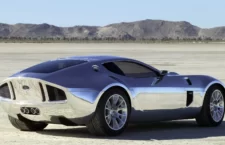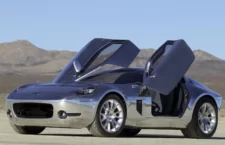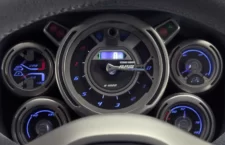
In the realm of automotive dreams and daring concepts, Ford’s 2004 Shelby GR-1 stands tall as a breathtaking specimen that almost made it to the streets. Following the resounding success of its mid-engined GT, Ford recognized the need for a worthy successor. Enter George Saridakis, an in-house designer with a penchant for paying homage to the iconic ’60s Shelby Daytona Coupe. Under the watchful eye of J. Mays, Ford’s head of design, Saridakis crafted a clay model that captured the essence of the past while embracing the future.
The GR-1 concept made its grand entrance at the prestigious Pebble Beach Concours, where it received a warm reception and sent shockwaves through the automotive community. The folks at Ford’s Advanced Product Creation (APC) team were charged with the challenging task of turning this clay vision into a fully functional beast—one that could potentially see the light of day on the production line.
The result was nothing short of astonishing. Leveraging the mid-engined GT’s chassis as a solid foundation, the APC team modified it to accommodate a thunderous 597 horsepower, 6.4-liter, dry-sump V-10 engine. With a classic cab-rearward stance and a polished aluminum fastback design, the GR-1 exuded muscularity and raw power. It stood at 14.5 feet in length, two feet shorter than its GT sibling, and flawlessly blended cues from the original Shelby without resorting to overt retro styling.
The GR-1’s McLaren-style “butterfly” doors swung open, revealing an interior that seamlessly merged analogue and digital elements. The dash, a clean and purposeful creation, housed a ‘TireIQ’ system that recorded cornering G-forces through an accelerometer. Adding a touch of sonic delight, the sound system’s speakers were ingeniously integrated into the headrest wings of the carbon fiber-shelled seats.
But this wasn’t just an exercise in style; the GR-1 had the performance credentials to back up its aggressive appearance. The mighty V-10 engine, plucked from Ford’s Modular family, promised a top speed of 190 mph and a blistering 0-60 mph sprint in just 3.9 seconds. Power coursed through a limited-slip-differential-equipped six-speed manual transaxle, culminating in the forceful grip of 19-inch rear wheels wrapped in 345 x 35 tires.
The 2005 North American International Auto Show marked the GR-1’s public debut, and the clamor for a production version was undeniable. Phil Martens, Ford’s group vice president of product creation, emphasized the GR-1’s unique market positioning: it aimed to strike a harmonious balance of design, capability, and usability, appealing to those considering the likes of a Ferrari 575M Maranello.
However, as with many tantalizing concept cars, the devil lay hidden within the details. A full feasibility study exposed the challenges that stood in the way of making the GR-1 a reality. To achieve production viability, the car’s height had to be raised from its original 45 inches, and its wheelbase—already seven inches shorter than the GT’s—needed further elongation. Weight was another concern, with the concept tipping the scales at a hefty 3,900 pounds. Ford aimed for a target production weight of 3,500 pounds and even explored the possibility of swapping the V-10 for a V-8 to achieve that goal.
In the end, Ford’s ambitions for the GR-1 to grace the streets with its presence were dashed. Despite the challenges not being insurmountable for the development team, the company had learned a harsh lesson from the GT sales saga. After the initial frenzy surrounding
its launch in 2004, demand for the GT had waned significantly by 2006. With the prospect of selling only 4,000 units out of the initially planned 4,500, Ford’s accountants couldn’t ignore the potential financial risks of introducing the GR-1 into a market that showed signs of saturation. Reluctantly, they made the difficult decision to halt the GR-1’s production plans, slamming on the brakes and dashing the hopes of enthusiasts eagerly awaiting its arrival.
Yet, as the saying goes, every cloud has a silver lining. The GR-1 had garnered a devoted following among automotive enthusiasts, and one man saw the potential for its resurrection in a more specialized market. Lance Stander, the CEO of Superformance, a California-based distributor known for their high-end recreations of legendary vehicles, set his sights on acquiring the rights to produce a modified version of the GR-1. After years of negotiations and perseverance, Stander and his team succeeded.
In 2019, Superformance proudly announced that they would be accepting orders for their own iteration of the Shelby GR-1. Building upon the original concept’s legacy, they offered customers the choice between an aluminum or carbon fiber body, promising an astounding 750 horsepower from a Ford V-8 engine. The projected price tag for this exceptional machine stood at a cool $250,000, embodying the ethos of exclusivity and performance that enthusiasts craved.
Unfortunately, just as the dream was becoming a reality, the federal government dealt a significant blow. They abruptly halted the implementation of a regulation that would have granted Superformance exemption from the stringent safety and labeling standards required for low-volume production of the Shelby GR-1. The news left fans and prospective buyers disheartened, as the hope of owning this revived marvel suddenly appeared uncertain.
While the fate of the Superformance Shelby GR-1 hangs in the balance, one thing remains undeniable—the enduring allure of this striking concept and its transformation into a limited-production reality. Whether it ultimately conquers the challenges presented by regulations or becomes an elusive dream, the GR-1 will forever occupy a cherished place in the hearts and minds of automotive enthusiasts. Its design prowess and performance potential pay homage to the legacy of Shelby, capturing the spirit of the past while embodying the relentless pursuit of automotive excellence in the 21st century.










Be the first to comment